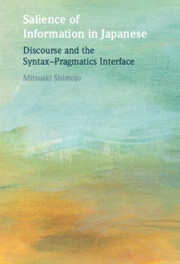Refine search
Actions for selected content:
6584 results in Grammar and Syntax
3 - Backward-Looking Salience and Argument Forms
-
- Book:
- Salience of Information in Japanese
- Published online:
- 28 March 2024
- Print publication:
- 04 April 2024, pp 42-112
-
- Chapter
- Export citation
Index
-
- Book:
- Salience of Information in Japanese
- Published online:
- 28 March 2024
- Print publication:
- 04 April 2024, pp 261-264
-
- Chapter
- Export citation
1 - Introduction
-
- Book:
- Salience of Information in Japanese
- Published online:
- 28 March 2024
- Print publication:
- 04 April 2024, pp 1-7
-
- Chapter
- Export citation
6 - Forward-Looking Non-salience and Argument Forms
-
- Book:
- Salience of Information in Japanese
- Published online:
- 28 March 2024
- Print publication:
- 04 April 2024, pp 197-237
-
- Chapter
- Export citation
Figures
-
- Book:
- Salience of Information in Japanese
- Published online:
- 28 March 2024
- Print publication:
- 04 April 2024, pp vii-viii
-
- Chapter
- Export citation
Abbreviations
-
- Book:
- Salience of Information in Japanese
- Published online:
- 28 March 2024
- Print publication:
- 04 April 2024, pp xv-xvi
-
- Chapter
- Export citation

Salience of Information in Japanese
- Discourse and the Syntax–Pragmatics Interface
-
- Published online:
- 28 March 2024
- Print publication:
- 04 April 2024
List of Abbreviations
-
- Book:
- Modern Linguistics in Ancient India
- Published online:
- 14 March 2024
- Print publication:
- 21 March 2024, pp xi-xii
-
- Chapter
- Export citation
Glossary
-
- Book:
- Modern Linguistics in Ancient India
- Published online:
- 14 March 2024
- Print publication:
- 21 March 2024, pp ix-x
-
- Chapter
- Export citation
Author Index
-
- Book:
- Modern Linguistics in Ancient India
- Published online:
- 14 March 2024
- Print publication:
- 21 March 2024, pp 246-249
-
- Chapter
- Export citation
4 - Morphological Systems
-
- Book:
- Modern Linguistics in Ancient India
- Published online:
- 14 March 2024
- Print publication:
- 21 March 2024, pp 78-106
-
- Chapter
- Export citation
5 - Syntax: Argument Structure
-
- Book:
- Modern Linguistics in Ancient India
- Published online:
- 14 March 2024
- Print publication:
- 21 March 2024, pp 107-136
-
- Chapter
- Export citation
Frontmatter
-
- Book:
- Modern Linguistics in Ancient India
- Published online:
- 14 March 2024
- Print publication:
- 21 March 2024, pp i-iv
-
- Chapter
- Export citation
The Sanskrit Transcription System
-
- Book:
- Modern Linguistics in Ancient India
- Published online:
- 14 March 2024
- Print publication:
- 21 March 2024, pp xviii-xx
-
- Chapter
- Export citation
2 - The Aṣṭādhyāyī at Work
-
- Book:
- Modern Linguistics in Ancient India
- Published online:
- 14 March 2024
- Print publication:
- 21 March 2024, pp 32-54
-
- Chapter
- Export citation
Subject Index
-
- Book:
- Modern Linguistics in Ancient India
- Published online:
- 14 March 2024
- Print publication:
- 21 March 2024, pp 240-245
-
- Chapter
- Export citation
7 - Semantics and Pragmatics: Compositionality and the Relation between Grammar and Meaning
-
- Book:
- Modern Linguistics in Ancient India
- Published online:
- 14 March 2024
- Print publication:
- 21 March 2024, pp 165-187
-
- Chapter
- Export citation
Acknowledgements
-
- Book:
- Modern Linguistics in Ancient India
- Published online:
- 14 March 2024
- Print publication:
- 21 March 2024, pp vii-viii
-
- Chapter
- Export citation
Texts and Authors
-
- Book:
- Modern Linguistics in Ancient India
- Published online:
- 14 March 2024
- Print publication:
- 21 March 2024, pp xiii-xvii
-
- Chapter
- Export citation
8 - Phonology: Phonemes and Writing Systems
-
- Book:
- Modern Linguistics in Ancient India
- Published online:
- 14 March 2024
- Print publication:
- 21 March 2024, pp 188-212
-
- Chapter
- Export citation
